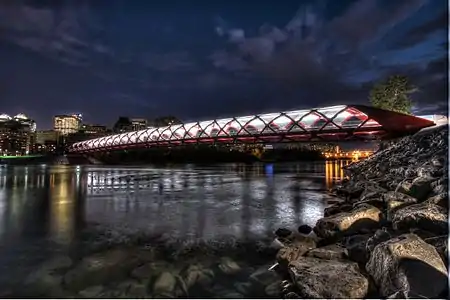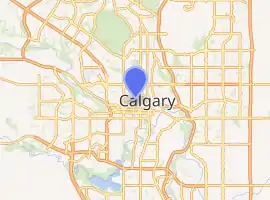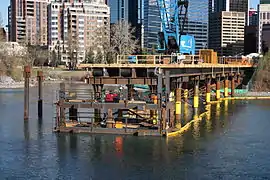Peace Bridge (Calgary)
Peace Bridge is a bridge that accommodates people walking and cycling across the Bow River in Calgary, Alberta, Canada. The bridge, designed by Spanish architect Santiago Calatrava, opened for use on March 24, 2012. It has the popular nickname "Finger Trap Bridge" due to its visual similarity to the finger trap puzzle.[1]
Peace Bridge | |
|---|---|
 | |
| Coordinates | 51.05389°N 114.07883°W |
| Carries | Pedestrian pathway, bike path |
| Crosses | Bow River |
| Official name | Peace Bridge |
| Maintained by | City of Calgary |
| Characteristics | |
| Design | Double helix tubular truss |
| Material | Steel |
| Total length | Out to Out 130.6 meters (428 ft) |
| Width | 6.2 meters (20 ft) |
| Height | 5.85 meters (19.2 ft) |
| No. of spans | 1 |
| Piers in water | 0 |
| History | |
| Designer | Santiago Calatrava |
| Constructed by | Graham Group Ltd. |
| Construction start | March 2010 |
| Construction end | March 2012 |
| Opened | 2012-03-24 |
| Location | |

| |
The bridge was built by The City of Calgary to connect the southern Bow River pathway and Downtown Calgary with the northern Bow River pathway and the community of Sunnyside. This connection was designed to accommodate the increasing number of people commuting to and from work and those utilizing Calgary's pathways. The bridge is reportedly used by 6000 people a day and has ranked among the top 10 architectural projects in 2012 and among the top 10 public spaces of 2012.[2][3]
Design
The design follows strict requirements with no piers in the water (in an effort to minimize the ecological footprint) and restricted height (due to the vicinity of the City/Bow River Heliport).
The bridge has also been designed to:
- Withstand Calgary's one-in-100 year flood cycle
- Meet a minimum 75 year life span
- Allow barrier free access for people of all mobility types
- Provide comfort and security through lighting[4]
The bridge is a departure from Calatrava's previous designs, which were typically asymmetric shapes anchored by high masts.[5] Another atypical element is the color; while most of Calatrava's designs are white, the Peace Bridge features red and white as used in both the Flag of Canada and the Flag of Calgary.
- Features
- Helical steel structure with a glass roof (850-metric-tonne steel)
- A width of 6.3 metres - double the width of other pedestrian bridges in the area
- Segregated bicycle and pedestrian traffic
- Lighting for night time use
- Materials used
- Steel for the arches
- Reinforced concrete abutments & deck
- Dimensions
- Span length: Tube Girder 126 meters (413 ft)
- Total length: Out to Out 130.6 meters (428 ft)
- Total width: 8 meters (26 ft)
- Total height: 5.85 meters (19.2 ft)
- Inside width: 6.2 meters (20 ft) (3.7 meters (12 ft) for pedestrian and 2.5 meters (8.2 ft) for cycleway)[6]
Cost
Funding for the Peace Bridge was provided by the city's capital budget. For the transportation department, targeted expenditures of capital are directed by the Transportation Infrastructure Investment Program (TIIP), which defines the priority and timing of major infrastructure construction projects. This program emphasizes pedestrian and cycling in high-density areas where these modes are more efficient at moving people, supporting land use and lessening environmental impacts.[7] As of February 2012, the approximate costs were:
- Construction: $17.995 million
- Architectural and structural design, specialized engineering and quality assurance: $3.9 million
- Project administration and contingency: $2.6 million[8]
History
On September 8, 2008, Calgary City Council approved report LPT2008-49 which set aside $25 million for the Pedestrian Gateways project for two bridges across the Bow River: one west of Prince's Island Park and one at the west of St. George's Island. The decision directed Administration to design and build one bridge and develop a concept design for a second one.
Construction started in March 2010. A temporary structure was built immediately upstream from the bridge location and served as a place to assemble the bridge before moving it to its final position.
The tubular bridge was manufactured in Spain and shipped to Calgary. Assembly of the bridge pieces started in Fall 2010 and the bridge was moved across the Bow River in November 2011.[9][7]
During routine weld inspection, it was discovered that some of the welds did not comply with quality standards. As a result, the city hired an independent inspection company to do a more thorough inspection of the welds completed in Spain.[10] The added inspections, red flags about the steel work's esthetics, weld repairs, and issues with damaged concrete slabs all contributed to multiple delays in the opening of the bridge.[11][12][13]
The bridge, originally supposed to be opened in the fall of 2010, opened to the public on March 24, 2012.[14]
To commemorate Canada Day 150, the Red Ball Project was installed for a day (June 26, 2017) on Calgary's Peace Bridge.
 The temporary bridge built to support the construction in May 2010
The temporary bridge built to support the construction in May 2010 Temporary bridge completed in June 2010
Temporary bridge completed in June 2010 Assembly of the segments in Calgary
Assembly of the segments in Calgary
 The Red Ball Project installed inside the Calgary Peace Bridge June 26, 2017
The Red Ball Project installed inside the Calgary Peace Bridge June 26, 2017
Criticism
The Peace Bridge has drawn much criticism from the public, namely:
- There are three other pedestrian bridges 275m west, 400m west, and 900m east, from its location. However, the Peace Bridge is the only bridge, in Calgary, to provide dedicated bicycle lanes crossing the Bow River.
- The design was single-sourced.
- The design was awarded to a foreign firm.
- The bridge crosses to the north bank of the Bow River, but does not extend over a busy arterial road (Memorial Drive)[15]
- The final cost is projected to be over $30,400 per square metre.
- Some journalists have asserted the Peace Bridge has a lower cost per area than similar length pedestrian/cycle bridges.[16]
- Other indicators place the Peace Bridge amongst the most expensive bridges in cost per metre length at roughly €114,000 (2010 equivalent);[17] it was almost 10 times the $3 million cost of the Pedro e Inês bridge built in 2007 which spans 600 ft.[18]
The bridge bears some similarity to the Hans Wilsdorf Bridge in Geneva, designed by the architectural firm of Brodbek-Roulet.[19]
See also
Sources
- "thestar.com - The Star - Canada's largest daily". thestar.com.
- "2012 in Review: Top 10 Projects - Azure Magazine".
- "designboom 2012 top ten: public spaces". December 28, 2012.
- TI. "The City of Calgary -".
- World Architecture News (August 9, 2009). "A stretch for Calatrava". Retrieved September 12, 2009.
- "Archived copy". Archived from the original on February 22, 2012. Retrieved March 1, 2012.CS1 maint: archived copy as title (link)
- The City of Calgary. "Peace Bridge project page". Archived from the original on February 22, 2012. Retrieved March 1, 2012.
- TI. "The City of Calgary -".
- CBC News (October 6, 2010). "Peace Bridge pieces come together". Retrieved October 6, 2010.
- The City of Calgary (April 1, 2011). "Pedestrian bridge delayed news release". Archived from the original on July 14, 2012.
- Calgary Herald (February 21, 2012). "Cost overruns forecast for Peace Bridge project, estimates reveal" (PDF).
- CBC News (April 1, 2011). "Peace Bridge plagued by further delays".
- CBC News (February 1, 2012). "Calgary Peace Bridge delayed, again".
- CBC. "Peace Bridge party kicks off grand opening". Retrieved March 25, 2012.
- CBC News. "City examines new bridge and Peace Bridge crosswalk". Retrieved March 28, 2012.
- Jason Markusoff. "Calgary's $24.5M footbridge unveiled to cheers, jeers". Retrieved March 25, 2011.
- "Benchmarking Cost and Value of Landmark Footbridges" (PDF).
- "Cecil Balmond and the Bonfire of the Vanities".
- Wallpaper Case Studies
| Wikimedia Commons has media related to Peace Bridge (Calgary). |